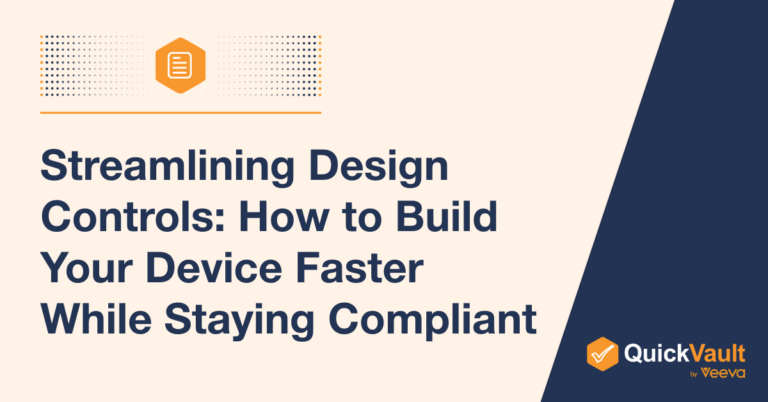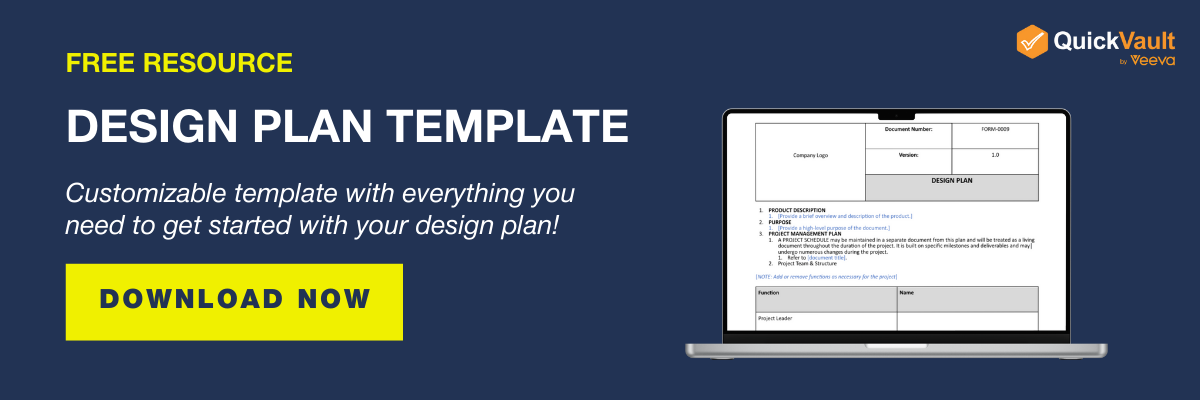
For MedTech startups, speed is everything. Investors expect traction. Founders want to see their ideas come to life. And patients—ultimately—can’t wait. And amid the rush to develop and deliver, design controls can feel like an obstacle: a set of regulatory hoops to jump through on the way to FDA clearance.
That perception is not only outdated—it’s risky. When approached strategically, design controls can actually help you build safer, better products faster. In this post, we’ll explore how startups can integrate compliance into their development process without slowing down innovation—and why doing so gives you a long-term advantage.
What Are Design Controls and Why Do They Matter?
Design controls are a regulatory requirement—but they’re also much more than that. At their core, design controls are a structured approach to product development. They are an often-iterative series of steps that ensure medical devices are safe, effective, and meet the needs of end users.
For startups trying to move fast and break new ground, understanding these controls can be the difference between costly delays and confident progress.
A Quick Primer on FDA Design Control Requirements (21 CFR 820.30)
The FDA’s Quality System Regulation (QSR) includes a section—21 CFR 820.30—that outlines the expectations for design controls in medical device development. These rules apply to nearly all Class II and III devices, and even some Class I products with software or specific risk profiles.
And while the FDA recently announced its intention to harmonize these with ISO 13485, the fundamental concepts of design controls will remain unchanged.
The goal of these regulations is to ensure that devices:
- Perform as intended,
- Address real user and patient needs, and
- Meet applicable safety and regulatory requirements.
The regulation mandates a systematic approach to managing the design and development process, including documentation, reviews, and traceability.
Key Components of Design Controls
Here’s a breakdown of the core elements within 21 CFR 820.30:
- Design and Development Planning
The bedrock of the development effort, the D&D plan outlines the goals of the project, delineates responsibilities, and identifies the major tasks, deliverables, milestones, and timelines. It also specifies what documentation will be generated and who is responsible for reviewing it.
- Design Inputs
The product’s starting point: design inputs specify what the device must do. These are derived from user needs, intended use, regulatory requirements, and applicable standards. These inputs form the foundation for development tasks as well as subsequent verification and validation activities. - Design Outputs
The tangible results of the design effort—specifications, drawings, software code, manufacturing instructions—that must align with the inputs. - Design Verification
Confirmation that outputs meet the inputs. This answers the question: Did we build the device right? - Design Validation
Ensures the device meets user needs in the real world, addressing the question: Did we build the right device? - Design Reviews
Formal checkpoints during development where multidisciplinary teams evaluate progress, identify issues, and document decisions. - Design Transfer
The transition from development to production—ensuring the device can be manufactured consistently according to the design. - Design Changes
A controlled process for evaluating and documenting changes during or after development to avoid unintended consequences. - Design History File (DHF) / Design and Development File
A complete record showing how the design evolved and how it meets its final requirements. This is a key deliverable during audits or FDA submissions, serving as a central source of information for the post-market device. - Risk Management (per ISO 14971)
While not explicitly listed in 21 CFR 820.30, modern quality systems integrate risk management throughout the design process to ensure hazards are identified, evaluated, and mitigated.
Why Startups Can’t Afford to Overlook Design Controls—But Timing Matters
For many MedTech startups, the instinct is to postpone formal design controls. And that instinct isn’t wrong—at least not entirely. That doesn’t mean design controls aren’t important—it means they’re most effective when introduced at the right moment.
In the earliest phases, teams need to move fast—testing ideas, demonstrating core functionality, and gathering user input. Applying rigid documentation requirements too soon can lead to wasted effort and unnecessary revisions as the concept evolves.
By focusing on architectural planning and risk awareness, startups can maintain speed without losing sight of quality. Once the concept works and key requirements are validated, formal design controls become a powerful accelerator. That’s when structured documentation and traceability help teams:
- Ensure Safety and Efficacy
Mistakes in design can have life-threatening consequences. Formal controls reduce the risk of design flaws going undetected. - Enable Lifecycle Traceability
Clear links between risks, requirements, design features, and testing outcomes are critical. You must be able to show that a risk was identified, mitigated with a design feature, and verified as effective. - Avoid Regulatory Delays
Whether it’s an FDA submission or ISO 13485 certification, auditors will ask to see a well-structured design history. And you can’t build that overnight. - Accelerate Development
Done well, design controls streamline—not slow—your path to market. When teams align on requirements, risks, and test plans early, they reduce rework, avoid surprises, and move faster.
The key isn’t doing everything up front—it’s doing the right things at the right time.
Want to dive deeper into how early-stage MedTech teams can scale faster without sacrificing compliance?
Watch the free webinar from Nocturnal and QuickVault, Scaling from Prototype to Commercial Success: A Lean Approach for MedTech Startups, to learn practical strategies for applying the right level of design controls at the right time—and how the right tools and planning can help turn compliance into a competitive advantage.
Turning Compliance into Acceleration
The truth is, design controls aren’t just about compliance—they are rooted in sound project management principles. When baked into the development process from the outset, they help product teams:
- Catch issues earlier: Design reviews surface risks before they become expensive problems.
- Stay aligned: Clear inputs and outputs ensure your team stays focused on solving the right problems.
- Reduce iteration cycles: Verification and validation prevent endless prototyping and guesswork.
Done right, compliance doesn’t slow you down—it keeps you moving in the right direction.
Tools and Tactics for Streamlining Design Controls
Startups today have a major advantage: modern tools built specifically for them. Solutions like QuickVault by Veeva offer out-of-the-box eQMS functionality tailored to the needs of growing MedTech companies. Here are some of the key benefits they provide:
- Pre-built templates for design control documentation
- Automated traceability between inputs, outputs, risks, and testing
- Collaborative workflows for design reviews, training, and quality events
- Regulatory readiness with built-in audit trails and change control
Instead of wrangling spreadsheets and scattered folders, your team can work in a unified system that supports both innovation and compliance.
How the Right Partners and Tools Drive Faster Time-to-Market
The most successful MedTech teams build quality into their process from the beginning. They treat design controls not as a burden, but as a way to clarify thinking, reduce risk, and increase their startup’s valuation.
They understand design controls aren’t in the way—they are the way. When implemented thoughtfully, this approach can help startups avoid common pitfalls as well as accelerate regulatory readiness and time to market.
Strategic partners like Nocturnal help early-stage teams strike this balance, bringing deep regulatory expertise and a phase-based approach that reduces risk while keeping momentum.
Paired with tools like QuickVault, which provides purpose-built eQMS functionality for managing design controls, risks, and traceability in one system, startups can move fast with confidence, turning compliance into a true accelerator.

